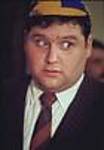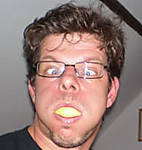You are viewing the archived version of the site.
Go to modelshipwrights.com for the current dynamic site!
Go to modelshipwrights.com for the current dynamic site!
Trinity House South Goodwin Lightship
5
Comments
"New MSW member Doug Hallet (budgie) sends in his first submission, a very impressive action build of the Trinity House South Goodwin Lightship, in this MSW Feature!"
Trinity House South Goodwin Lightship
110th Scale
Revell.DE
The Goodwins are a series of treacherous sand banks off Dover and Deal in the English Channel, and are the scene of many ship wrecks and lost lives. For the last 50+ years, they have been monitored by three light ships and a whole series of buoys, the most famous of them being the South Goodwin, which, as the name suggests, is positioned at the southern edge of the area.
The South Goodwin Lighthouse kit has been around since the 1960s, first released by the British firm Frog, later by the Russian Eastern Express and German Revell DE, if not others. The kit has always been a favorite of modelers, with excellent detailing for a kit out of that era.
I started this model some time ago, but the build really took off when I figured out the kit is perfect for the "compressed packing bead" style of sea base that I experimented with previously. This technique allows some pretty dramatic sea states with kits in large scales (those above 1/350) but will have little application for smaller ships.
Anyway, it goes something like this:
With an ordinary slab of bead-style packing foam, outline your ship's hull and carve out the appropriate shape deep enough to fit the hull in to the waterline. Then, decide on any waves or swells in your display and add additional, thinner slabs of foam in those locations, approximating the width of the wave in question.
After gluing in place and allowing to dry, use a Dremel tool with a feather wheel at an almost horizontal angle to gouge into the foam, creating an ungodly mess in the process and ending up with a surface closely resembling a lava field on the Big Island of Hawaii.
After a layer of black paint to determine depth, lay down 2-3 layers of glazing compound, allowing each to dry, until you have a horizontal, level surface on the lower portions of your surface. Then, use medium-thick polymer to build up and sculpt your waves, and paint to suit your preferences.
Although marketed by Revell, the kit includes rubbery railings and anchor chain that hearkens back to the original Frog model, making me suspect that Revell obtained a ware house full of them and re-boxed them. In any event, I replaced both as part of my build.
Other than some stretched sprue and fishing line for rigging, everything else is pretty much out of the box. Beware of the gigantic lettering on the side of the hull - these will need to be cut into individual letters if you are to have any hope of placing them successfully without multiple bubbles and wrinkles, and then be prepared for some touch-up around the portholes.
Thanks also to Peter Fulgoney, Guido Hopp and Frank Spahr for advice during the building process.
Trinity House South Goodwin Lightship
110th Scale
Revell.DE
The Goodwins are a series of treacherous sand banks off Dover and Deal in the English Channel, and are the scene of many ship wrecks and lost lives. For the last 50+ years, they have been monitored by three light ships and a whole series of buoys, the most famous of them being the South Goodwin, which, as the name suggests, is positioned at the southern edge of the area.
The South Goodwin Lighthouse kit has been around since the 1960s, first released by the British firm Frog, later by the Russian Eastern Express and German Revell DE, if not others. The kit has always been a favorite of modelers, with excellent detailing for a kit out of that era.
I started this model some time ago, but the build really took off when I figured out the kit is perfect for the "compressed packing bead" style of sea base that I experimented with previously. This technique allows some pretty dramatic sea states with kits in large scales (those above 1/350) but will have little application for smaller ships.
Anyway, it goes something like this:
With an ordinary slab of bead-style packing foam, outline your ship's hull and carve out the appropriate shape deep enough to fit the hull in to the waterline. Then, decide on any waves or swells in your display and add additional, thinner slabs of foam in those locations, approximating the width of the wave in question.
After gluing in place and allowing to dry, use a Dremel tool with a feather wheel at an almost horizontal angle to gouge into the foam, creating an ungodly mess in the process and ending up with a surface closely resembling a lava field on the Big Island of Hawaii.
After a layer of black paint to determine depth, lay down 2-3 layers of glazing compound, allowing each to dry, until you have a horizontal, level surface on the lower portions of your surface. Then, use medium-thick polymer to build up and sculpt your waves, and paint to suit your preferences.
Although marketed by Revell, the kit includes rubbery railings and anchor chain that hearkens back to the original Frog model, making me suspect that Revell obtained a ware house full of them and re-boxed them. In any event, I replaced both as part of my build.
Thanks also to Peter Fulgoney, Guido Hopp and Frank Spahr for advice during the building process.
Comments
Very nice looking project. I really like the motion of the ship and the feeling it envokes.
Thanks for sharing!
NOV 23, 2010 - 02:10 AM
A wonderful display of both a working ship of the sea (I wish we had more such kits!) and a dynamic water base technique--it makes one want to reach for the dramamine...
What an excellent way to capture a ship's purpose!
--Karl
NOV 23, 2010 - 10:43 AM
Well done, Doug!
It really turned out well. I like the new sets of pics, giving the sense of cross sea motion atop the sandbanks.
Cheers,
Guido
PS.: ... didn't even know you were lurking around MSW! Welcome!
NOV 23, 2010 - 08:54 PM
Thanks Guido and everyone. Actually, I ran across the site by following your Leipzig build article after you sent the link. Yes, kit turned out really well. This was only my third attempt at a sea scene, but lessons gleaned from other modelers were well used. The area where the water sloshes around near the bow and stern almost built itself - that's where I bridged the gap in the hole I cut for the hull with polymer, and when hardened to white, it looked so perfect that I just repainted it similarly. Next build is already under way - this time 1/375 Revell APA using the hard, pink Styrofoam. Base is already completed and kit almost ready for painting, so you should see before too long. Cheers, Doug
NOV 24, 2010 - 03:49 AM
Copyright ©2021 by Doug Hallet . _OPINIONS Model Shipwrights, KitMaker Network, or Silver Star Enterrpises. Images also by copyright holder unless otherwise noted. Opinions expressed are those of the author(s) and not necessarily those of Model Shipwrights. All rights reserved. Originally published on: 2010-11-23 00:00:00. Unique Reads: 20257

























